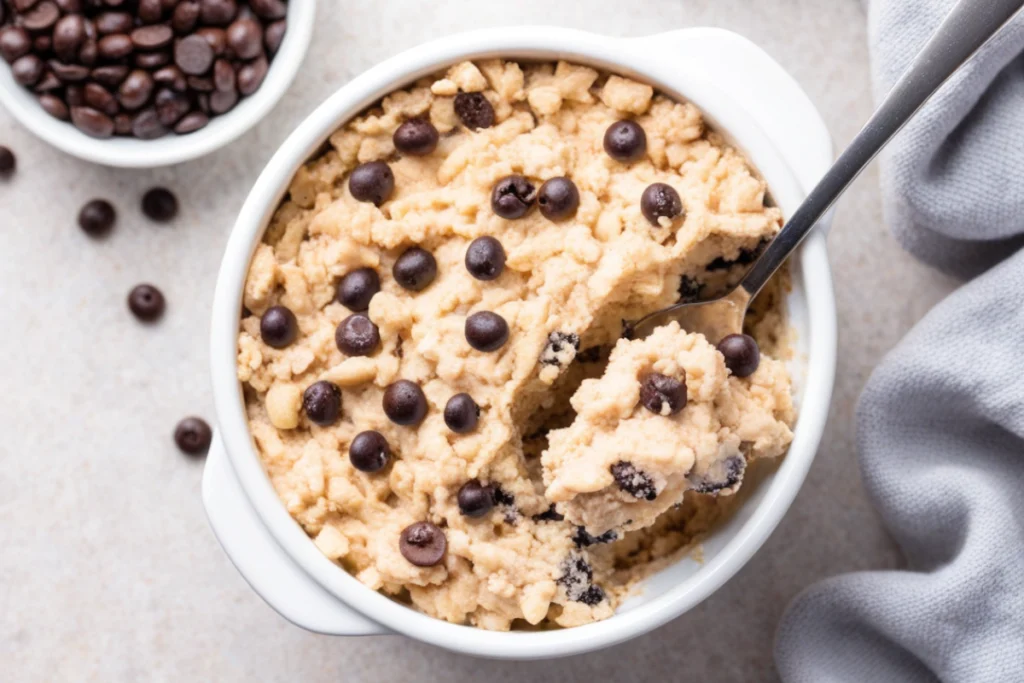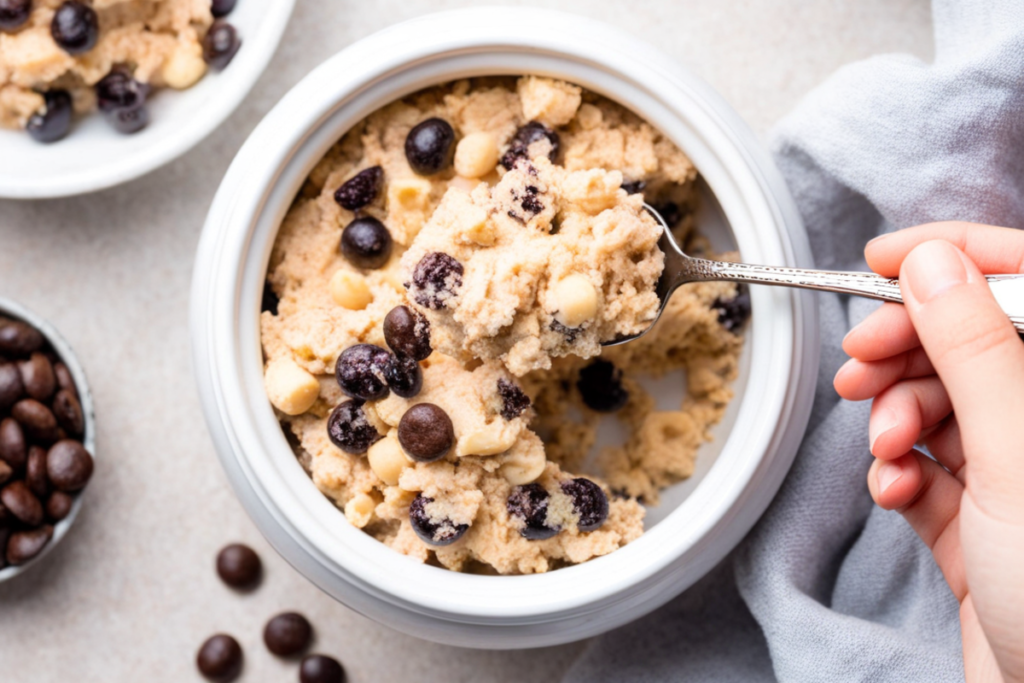Cottage Cheese Cookie Dough is a delicious and nutritious twist on traditional cookie dough, offering a high-protein, low-sugar alternative that has taken the internet by storm. As more people seek healthier dessert options, this unique recipe has become a viral sensation, especially on platforms like TikTok. In this comprehensive guide, we will explore everything you need to know about cottage cheese cookie dough, from its ingredients and preparation to its nutritional benefits and variations.
What is Cottage Cheese Cookie Dough?
Cottage Cheese Cookie Dough is an edible dough made from cottage cheese, almond flour, and natural sweeteners like honey or maple syrup. Unlike traditional cookie dough, which is often laden with refined sugars and unhealthy fats, cottage cheese cookie dough is designed to be a healthier, protein-rich option. This dough is not intended to be baked, making it a quick and easy treat for those looking to satisfy their sweet tooth without compromising their diet.
Nutritional Benefits of Cottage Cheese in Desserts
One of the main reasons cottage cheese cookie dough has gained popularity is its impressive nutritional profile. Cottage cheese is naturally high in protein, which makes it an excellent ingredient for those looking to increase their protein intake. Here are some key benefits:
- High Protein Content: Cottage cheese is packed with casein protein, a slow-digesting protein that helps with muscle recovery and keeps you full longer.
- Low in Fat and Sugar: Depending on the type of cottage cheese you use, this dough can be relatively low in fat and free from added sugars. Opting for low-fat or fat-free cottage cheese can make the recipe even healthier.
- Rich in Calcium and Vitamin B12: Cottage cheese is an excellent source of calcium, which is essential for bone health, and vitamin B12, which is crucial for energy production and brain function.
For a deeper understanding of the health benefits of cottage cheese, check out Healthline’s comprehensive guide.
Ingredients and Substitutes

Creating the perfect cottage cheese cookie dough starts with selecting the right ingredients. Below is a list of essential components and their possible substitutes:
Essential Ingredients
- Cottage Cheese: The star of the recipe, providing the base and the creamy texture.
- Almond Flour: Adds a nutty flavor and helps bind the dough. Almond flour is also gluten-free, making this recipe suitable for those with gluten sensitivities.
- Sweeteners: Honey, maple syrup, or sugar-free syrups are commonly used. These natural sweeteners provide just the right amount of sweetness without the need for refined sugar.
- Vanilla Extract: Enhances the flavor of the dough, adding a sweet, aromatic note.
- Add-ins (Optional): Chocolate chips, nuts, or dried fruits can be added to customize the dough to your liking.
Substitutes
- Cottage Cheese Alternatives: Greek yogurt or ricotta cheese can be used if cottage cheese is not available, though the texture and taste will differ slightly.
- Flour Alternatives: Oat flour or coconut flour can be substituted for almond flour, but adjustments to the liquid content may be necessary.
- Vegan Options: Use a plant-based cottage cheese or blend soaked cashews to create a creamy base.
For more information on why almond flour is a great substitute for traditional flour, visit Medical News Today’s article.
Step-by-Step Preparation Guide
Making cottage cheese cookie dough is straightforward and can be done in just a few steps. Follow this guide to achieve the best results:
1. Gather Your Ingredients
- 2 cups of cottage cheese
- 2 ¼ cups of almond flour
- ¼ cup of honey or maple syrup
- 2 teaspoons of vanilla extract
- Optional: ½ cup of chocolate chips, nuts, or dried fruits
2. Blend the Cottage Cheese
- In a food processor or blender, blend the cottage cheese until it reaches a smooth, creamy consistency. This step is crucial to ensure that the dough has the right texture.
3. Mix in the Dry Ingredients
- In a large mixing bowl, combine the almond flour and vanilla extract. Gradually add the blended cottage cheese and mix until well incorporated.
4. Add the Sweetener
- Pour in the honey or maple syrup and mix thoroughly. Adjust the sweetness according to your preference.
5. Fold in the Add-ins
- If you’re using chocolate chips, nuts, or dried fruits, gently fold them into the dough until evenly distributed.
6. Chill the Dough
- For the best texture, chill the dough in the refrigerator for at least 30 minutes before serving.
7. Serve and Enjoy
- The dough can be eaten as-is or used as a topping for yogurt, fruit, or other desserts.
Variations of Cottage Cheese Cookie Dough
The versatility of cottage cheese cookie dough means there are endless possibilities for customization. Here are a few popular variations:
1. Chocolate Chip Cottage Cheese Cookie Dough
- A classic twist that incorporates dark or semi-sweet chocolate chips into the dough. This variation is perfect for chocolate lovers who want a healthier version of their favorite treat.
2. Peanut Butter Cottage Cheese Cookie Dough
- Add ¼ cup of natural peanut butter to the dough for a rich, nutty flavor. This variation is not only delicious but also adds an extra boost of protein.
3. Low-Carb, Keto-Friendly Version
- Replace the honey or maple syrup with a keto-friendly sweetener like erythritol or monk fruit sweetener. Use coconut flour instead of almond flour to reduce the carb count.
4. Fruity Cottage Cheese Cookie Dough
- Incorporate dried fruits like cranberries, raisins, or chopped apricots for a burst of natural sweetness and texture.
These variations allow you to tailor the recipe to your taste and dietary preferences, making it a versatile addition to your healthy dessert repertoire.
Serving Suggestions and Pairings
Cottage cheese cookie dough is a versatile treat that can be enjoyed in many ways. Here are some serving suggestions:
- As a Standalone Snack: Enjoy the dough on its own as a quick, protein-packed snack.
- With Yogurt: Mix the dough into a bowl of Greek yogurt for a delicious and satisfying breakfast.
- Topping for Fruits: Use the dough as a topping for fresh fruits like strawberries, bananas, or apples.
- Dipping in Chocolate: For an indulgent treat, dip spoonfuls of the dough in melted dark chocolate and chill until set.
Storage Tips and Shelf Life
Proper storage is key to maintaining the freshness and texture of your cottage cheese cookie dough. Here are some tips:
- Refrigeration: Store the dough in an airtight container in the refrigerator for up to one week.
- Freezing: If you want to keep the dough for longer, you can freeze it. Portion the dough into small, bite-sized pieces before freezing to make it easy to thaw and enjoy later.
- Thawing: When ready to eat, thaw the frozen dough in the refrigerator overnight. Avoid thawing at room temperature, as this can cause the dough to become too soft.
Cottage Cheese Cookie Dough in Popular Culture
The rise of cottage cheese cookie dough can largely be attributed to social media, where influencers and food bloggers have shared their takes on this protein-packed dessert. TikTok, in particular, has played a significant role in making this recipe go viral. The platform’s short, engaging videos have made it easy for users to share their variations and tips, leading to a surge in popularity.
This trend highlights the power of social media in shaping food culture and driving the popularity of healthier alternatives to traditional treats. The recipe’s success also underscores a growing interest in high-protein, low-sugar snacks that align with modern dietary trends.
FAQs about Cottage Cheese Cookie Dough
Can I use low-fat or fat-free cottage cheese?”
- Yes, you can use low-fat or fat-free cottage cheese to reduce the calorie content of the dough. However, the texture may be slightly less creamy compared to using full-fat cottage cheese.
2. How can I make cottage cheese cookie dough vegan?
- To make a vegan version, use a plant-based cottage cheese alternative, or blend soaked cashews with a bit of water to create a creamy base. Replace honey with agave syrup or maple syrup.
3. Is it safe to eat cottage cheese cookie dough raw?
- Absolutely! Unlike traditional cookie dough, this recipe is designed to be eaten raw since it doesn’t contain eggs or raw flour, which are common sources of foodborne illness.
4. What’s the difference between using almond flour vs. regular flour?
- Almond flour is gluten-free and lower in carbs than regular flour. It also has a nutty flavor that complements the creaminess of the cottage cheese. Regular flour can be used, but it will alter the taste and texture.
5. Can I bake the dough into cookies?
- While cottage cheese cookie dough is designed to be eaten raw, some people have experimented with baking it. The result will be different from traditional cookies, as the dough is much softer and will not spread in the same way.
For more insights on the benefits of using natural sweeteners like honey or maple syrup, read this article from Mayo Clinic.
Conclusion
Cottage cheese cookie dough is more than just a viral trend—it’s a delicious, healthy alternative to traditional cookie dough that fits perfectly into a balanced diet. Whether you’re looking for a high-protein snack, a quick dessert, or a way to satisfy your sweet cravings without the guilt, this recipe has you covered. With endless variations and serving possibilities, cottage cheese cookie dough is a versatile treat that you’ll want to make again and again.
By understanding its nutritional benefits, experimenting with different flavors, and following proper storage methods, you can enjoy this protein-packed delight whenever you like. So why not give it a try and see why it’s become such a popular choice among health-conscious dessert lovers?




